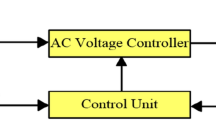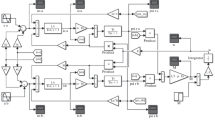The continually rising technical requirements of modern industrial drive applications often demand an improved, efficient and almost reliable design process. In particular, a very accurate prediction of undesired current and torque harmonic magnitudes as well as the accuracy of the rotor shaft's true running during load within converter fed induction motors become nowadays of crucial interest. So, the complex nonlinear interaction of the converter and the squirrel cage induction motor have to be considered and analyzed with adequate numerical methods. The proposed complete system approach takes thereby implicit account of a very detailed converter circuit representation with discrete electronic devices and an extensive 3D squirrel cage induction motor modeling by the finite element method. Various control strategies of the power converter – π-mode or manifold pulse width modulation methods – have been established in the past and are successfully used until now. The generated respective arbitrary time-dependent output voltage waveforms of the power converter are almost directly processed within the non-linear finite element analysis of the motor in the time-domain. Such numerical analysis methods deliver novel and deep insight into an almost very sensitive and complex speed-variable drive system.
Die stets steigenden technischen Anforderungen an moderne Industrieantriebe fordern immer mehr einen verbesserten, effizienten und vor allem zuverlässigen Entwicklungsprozess. Von besonderem Interesse bei umrichtergespeisten Motoren sind dabei die möglichst exakte Bestimmung von ungewünschten Amplituden im Strom- und Drehmomentspektrum sowie die Genauigkeit des Rotorrundlaufs unter Last. Das komplexe nichtlineare Zusammenwirken von Umrichter und Kurzschlussläufermotor muss daher mittels geeigneter numerischer Methoden nachgebildet und analysiert werden. Die vorgeschlagene Systembetrachtung macht dabei implizit Gebrauch von einer sehr detailgerechten Umrichternachbildung mit diskreten Bauelementen sowie einer sehr ausführlichen Darstellung des Kurzschlussläufermotors unter zu Hilfenahme der Finite-Elemente-Methode. Unterschiedliche Ansteuermethoden für den Umrichter – π-Steuerung oder vielfältige Pulsweitenmodulationsverfahren – wurden in der Vergangenheit etabliert und werden bis heute erfolgreich eingesetzt. Die jeweils erzeugten beliebig zeitabhängigen Verläufe der Ausgangsspannung des Umrichters werden dabei direkt in der nichtlinearen Finite-Elemente-Berechnung des Motors im Zeitbereich mitverarbeitet. Solche numerischen Analysemethoden liefern neuartige und sehr eingehende Einblicke in das meist sehr sensitive und komplexe Verhalten von drehzahlveränderbaren Drehstromantrieben.
Similar content being viewed by others
References
Bowes, S. R. (1975): New sinusoidal pulse width modulated inverter. IEE Proc., Vol. 122, No. 11.
Buja, G. S., Indri, G. B. (1977): Optimal pulse width modulation for feeding AC motors. IEEE Transactions on Industry Applications, Vol. IA-13, No. 1.
DeBortoli, M. J. (1992): Extensions to the finite element method for the electromechanical analysis of electrical machines. PhD Thesis, Rensselaer Polytechnic Institute, New York.
Grabner, C. (2005): A coupled electromagnetic-mechanical finite element approach for the transient analysis of squirrel cage induction motors. IEEE Canadian Conf. on Electrical and Computer Engineering, Saskatoon, 1–4. Mai 2005.
Heimbrock, A., Seinsch, H. O. (2005): Neue Erkenntnisse über die Oberschwingungsverluste in umrichtergespeisten Käfigläufern. e&i (122). Jahrang, Heft 7/8: 274–282.
Heintze, K., Tappeiner, H., Weibelzahl, M. (1971): Pulswechselrichter zur Drehzahlsteuerung von Asynchronmaschinen. Siemens Zeitschrift 45, Heft 3.
Holtz, J. (1992): Pulse width modulation – a survey. IEEE Transactions on Industrial Electronics, Vol. 39, No. 5.
Istfan, B. (1987): Extensions to the finite element method for nonlinear magnetic field problems. PhD Thesis, Rensselaer Polytechnic Institute, New York.
Jackson, S. P. (1970): Multiple pulse modulation in static inverters reduces selected output harmonics and provides adjustment of fundamentals. IEEE Transactions on Industry and General Applications, Vol. IGA-6, No. 4.
Kleinrath, H. (1980): Stromrichtergespeiste Drehfeldmaschinen, Wien: Springer.
Kliman, G. B., Plunkett, A. B. (1979): Development of a modulation strategy for a PWM inverter drive. IEEE Transactions on Industry Applications, Vol. IA-15, No. 1.
Kolar, J. W., Ertl, H., Zach, F. C. (1985): Efficiency optimal control for AC drives with PWM inverters. IEEE Transactions on Industry Applications, Vol. IA-21, No. 4.
Krieger, A. W., Salmon, J. C. (2005): Hysteresis-based current control at fixed frequency with a resonating integrator to eliminate the steady state error. IEEE Canadian Conf. on Electrical and Computer Engineering, CD Rom, May 2005.
Lipo, T. A., Krause, P. C., Jordan, H. E. (1969): Harmonic torque and speed pulsation in a rectifier-inverter induction motor drive. IEEE Transactions on Power Apparatus and Systems, Vol. PAS-88, No. 5.
Murphy, J. M. D., Egan, M. G. (1983): A comparison of PWM strategies for inverter-fed induction motors. IEEE Transactions on Industry Applications, Vol. IA-19, No. 3.
Patel, H. S., Hoft, R. G. (1973): Generalized techniques of harmonic elimination and voltage control in thyristor inverters. IEEE Transactions on Industry Applications, Vol. IA-9, No. 3.
Salon, J. S. (1996): Finite element analysis of electrical machines. Cambridge: Cambridge University Press.
Silvester, P. P. (1995): Finite elements for electrical engineers. Boston, London, Dortrecht: Kluwer Academic Publisher.
Stuart, D. T., Hebbar, K. M. (1971): Torque pulsation in induction motors with inverter drives. IEEE Transactions on Industry and General Applications, Vol. IGA-7, No. 2.
Vänänen, J. (1996): Circuit theoretical approach to couple two-dimensional finite element models with external circuit equations. IEEE Transactions on Magnetics, Vol. 31, No. 2.
Zach, F. C., Ertl, H. (1991): Influence of the modulation method on the conduction and switching losses of a pwm converter system. IEEE Transactions on Industry Applications, Vol. 27, No. 6.
Author information
Authors and Affiliations
Rights and permissions
About this article
Cite this article
Grabner, C. Progress report about coupled finite element calculations for squirrel cage induction motors including various control strategies of power converters. Elektrotech. Inftech. 123, 344–351 (2006). https://doi.org/10.1007/s00502-006-0364-9
Received:
Accepted:
Issue Date:
DOI: https://doi.org/10.1007/s00502-006-0364-9




